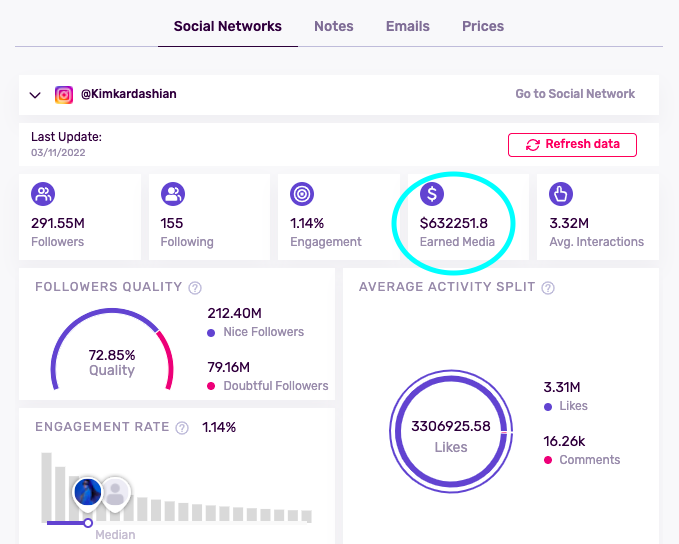What is the Earned Media Value Metric and How Is this Calculated?
Learn all about Earned Media Value and how it can help your influencer marketing strategy.
Earned Media Value (EMV) can be a huge asset when planning your strategy and budget, however, it can sometimes be hard to understand. Let us answer all your questions about EMV here.
What is Earned Media Value?
EMV is one of the main KPIs displayed when you analyze a profile in your IRM. Basically, it’s the monetary value given to all of the exposure (likes, comments, etc.) that you gain when you collaborate with an influencer on a post.
Think of it as the equivalent advertising value of a post. In the case of @Kimkardashian, her EMV is $632,251.80, meaning that if you collaborate with her on a post this would provide the same “advertising value” as $632,251.80 spent on Instagram ads.
EMV is what an profile earns organically versus what you would pay to achieve the same KPIs including reach, interactions, and impressions.

How Is Earned Media Value Calculated?
We take into account the standard paid media rates on the market when determining this value. Therefore, the paid media rates applicable to Kim Kardashian, an influencer and socialite based in California, USA, would be different from, say, a foodie micro-influencer in another country or region.
To get a better understanding of this, let’s look at this example:
The standard paid media rate for a given country or city dictates the dollar value of each like, interaction, view, etc. Imagine that in California this is fixed as $0.01. Therefore, every like, interaction or view that this influencer has “earned” organically would be given this value. Following this example, the EMV of a post with 1,000 likes would be calculated as follows: 1,000 x $0.01 = $10 EMV.
Is Earned Media Value How Much I Should Pay for a Collaboration?
EMV is not a recommendation for how much you should pay to collaborate with an influencer, this is something users would need to negotiate with an influencer directly, using the many tools available in the IRM.
Instead, consider the EMV as another way to compare profiles in order to make an informed decision about the one that is right for your campaign.
To illustrate this, imagine you are deciding between two influencers who are generally quite similar. Influencer A has an EMV of $75, meaning their posts provide the same “advertising value” as a $75 ad on Instagram, TikTok or YouTube. Influencer B, on the other hand, has an EMV of $100, providing an equivalent ad value of $100. In this case, influencer B provides more organic reach, and may be of better value to your company.